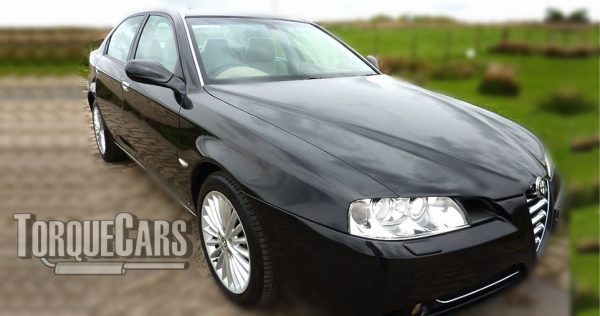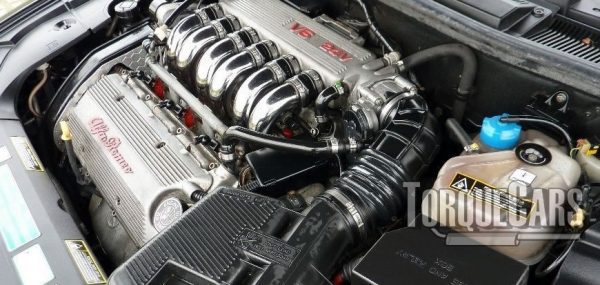Alfa Romeo 166 Tuning
"Tuning guide to the greatest Alfa Romeo 166 modifications."
We take a peek at the world of Alfa 166 tuning and point out the ultimate modifications. Alfa Romeo 166s make a good tuning project and with the optimum modified upgrades you can positively maximise your driving fun.
You can do a lot to improve the performance of your Alfa Romeo 166 with our step by step tuning tips. The key to Alfa Romeo 166 tuning is getting the right mods - a lot of money can be wasted if you do it wrong.
The 166 is a good project car to carry out. The key to 166 tuning is getting your choice of modification right - a lot of money can be wasted if you do it wrong.

Smaller engines do not provide much of a return in terms of power so start with a bigger engine. Engine swaps are a good option if you have a small engine size.
Power mods.
Typically these performance modifications are usually installed by our members, decide how far you want to go before you start.
Getting the right uprated mods for your planned usage of the car is a time and money saver. Stage 3 motor sport mods just don't work well on the road making the car difficult to drive.
Alfa Romeo 166 engine mods.
- 2.0 L Twin Spark
- 2.0 L Turbo V6
- 2.5 L V6
- 3.0 L V6
- 3.2 L V6
Some regions got a 2.4 JTD diesel engine as well, the 3.0V6 is our preferred engine but all the others are really good units and do very well with the right performance parts added.

Please watch TorqueCars Video tutorial on car tuning. And be sure to subscribe and support our new channel.
Guide to the Best Tuning Mods & Upgrades
- Mods that Remove a Restriction
If the intake or exhaust are restricted in any way this will have an impact on your cars performance, so use an induction kit/filter upgrade and better flowing exhaust whenever your tuning creates a flow restriction.
- Mods that Improve Handling
Braking, Suspension and general alignment of the suspension components is vital for any tuning project even before you start increasing power.
- Fit Stronger Parts
Tuned cars will show up weaknesses, typically in the turbochargers, clutch and internal engine components. Whilst most engines can cope with mild tuning mods, TorqueCars recommend that you upgrade the internal components before these weak spots manifest themselves.
- ECU Tunes & Remapping
While some cars can be easily remapped, others may require piggyback ECU's or aftermarket ECU's but this is the most vital step of your tuning project as it fully releases the power from all of your mods and upgrades. Expect 10-20% on NASP engines and 30-40% on turbocharged units.
- More Power Needs More Fuel & Air
Every tuning project will aim to increase the air supply, but fuel supply is just as vital and will need to match the air the engine can utilise. Fuel to Air ratio is vital so upgrade the fuel pump & injectors. Also you can look to perform head mods (flowing and porting), bigger valves, fast road cams and forced induction upgrades to improve fuel.
Stages of Tune
Stage 1 mods: Panel air filter, Lighter flywheel, Remap, Sports exhaust, Alloy wheels, Suspension upgrade (drop 28mm - 39mm).
Stage 2 mods: fuel pump upgrades, high flow fuel injector, Power/Sport clutch, Fast road cam, Ported and polished head.
Stage 3 mods: Competition cam, Adding or upgrading forced induction (turbo/supercharger), Internal engine upgrades (pistons/head/valves), Engine balancing, Sports gearbox.
You really need to keep as much low end torque as you can and aim to get a long power band rather than a narrow top end power hike.
The aim of our tips is to give a little insight into the world of modding modifications and point you in the right direction, our forum is best place to go if you need more detailed advice and tips on your modified car project, the best uprated parts and all aspects of modding cars.One of the biggest mechanical tuning modifications you can do to your NASP engine is to fit a fast road camshaft .
The intake and exhaust durations play a large part in your cars power band, but be careful here, getting this wrong can upset the idle and make the car difficult to drive in traffic. You'd need to follow a camshaft upgrade with other mods and finish with a reflashed ECU to fully release the power gain.
Don't forget to increase the fuelling when you are increasing the power - it makes the car more thirsty.
Most power losses, flat spots and erratic idling after kits are done can usually be traced to timing or fuel delivery issues.Larger injectors will enable you to supply sufficient fuel to the engine.
Uprate the fuel pump to cope with the extra fuel requirements of your tuned 166s uprated injectors.
Intake and Exhaust Tuning.
Breathing mods are usually next up. Please note that WE DO NOT RECOMMEND INDUCTION KITS, unless you have tuned your car with over 30 percent more power and are finding that the standard air intake has become limited.
Induction kits can work well on turbo engines and larger engines (if supplied with a suitable cold air feed or air box), generally though we'd just recommend for 166 engines you should go with a sports panel air filter preferably made from cotton.
Sports exhausts can usually air flow out of the engine but do not go too large or you could will reduce the flow rate. Stick to 1.5 to 2.5 inches for best results.
gas flowing the head will allow you to maximise your air/fuel charge. Leave this to a professional though with a proper flow bench and machine tools A good triple plate fast road performance clutch will help to keep that power going where it should. Never cut corners or assume the standard OEM clutch to cope. The best mods in our experience for your 166 are remaps, sports camshafts and induction improvements.
NASP engines do not achieve big power gains if you remap them, unless you have done extensive modifications. With turbocharged engines this is another story. A remapped turbo will give impressive power gains and fully release the potential power of the engine.
We've also come across some owners toying with twincharging conversions and making some seriously high power figures.
The most phenomenal power gains for NASP engines usually involve the addition of forced induction. It is generally cheaper to bolt on a supercharger than it is to fit a working turbo. With a turbo the boost curve is related exponentially to the engine speed making it difficult to map fuelling with.
Superchargers however will give a boost which is correlating to engine speed so is simpler. Adding forced induction will nearly always require a lower compression ratio or water injection.
Handling/Suspension upgrades
Handling modifications are the thing most do first for the 166.
Adding a small amount of negative camber to the front and a few degrees of toe out, will dramatically improve your 166 in handling and cornering.
We would go to a maximum drop of 28mm - 39 mm on most models. You risk handling compromises if you go lower than this.
Alloy wheel upgrades.
Alloy wheels will help the brakes cool down and are usually lighter than the steel ones. We can't go into too much detail here about tyres but they are how the car puts the power down on the road so are a critical choice. soft compound tyres work well on 166, and make a big difference over budget tyres. Large 166 alloy wheels can decrease performance. If you get big alloy wheels you will be changing your final drive ratio.
Because of this we would advise sticking to a maximum wheel size of 17 or possibly 18 inches, although we know some of our members have with bigger wheels with no problems.
There is a more updated version of this Alfa Romeo 166 Tuning article on TorqueCars.com.
For more information on Tuning your car please join us in our friendly forum where you can discuss 166 options in more detail with our 166 owners. It would also be worth reading our unbiased Alfa Romeo tuning articles to get a full grasp of the benefits and drawbacks of each modification.
We need your help improving this article, so please send us your feedback in the comments box below and pass on any tips, points or facts we have wrong or have not covered.
We really do love seeing our visitors car projects and which mods work best for them, this site is very much a community effort, and we remind our visitors of our non profit non commercial approach to running this site.
All of your comments are used to improve the accuracy of these articles which are continually revised, tweaked and updated.
Please Check out my YouTube channel, we're regularly adding new content...
PLEASE HELP: I NEED YOUR DONATIONS TO COVER THE COSTS OF RUNNING THIS SITE AND KEEP IT RUNNING. I do not charge you to access this website and it saves most TorqueCars readers $100's each year - but we are NON PROFIT and not even covering our costs. To keep us running PLEASE Donate here
If you liked this page please share it with your friends, drop a link to it in your favourite forum or use the bookmarking options to save it to your social media profile.
Feedback - What do You Think?
Please use our forums if you wish to ask a tuning question, and please note we do not sell parts or services, we are just an online magazine.
Help us improve, leave a suggestion or tip
Please watch this video and subscribe to my YouTube channel.

 Click to accept YouTube Cookies & Play.
Click to accept YouTube Cookies & Play.